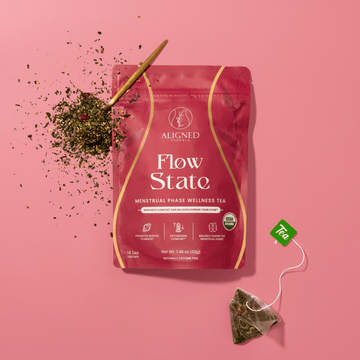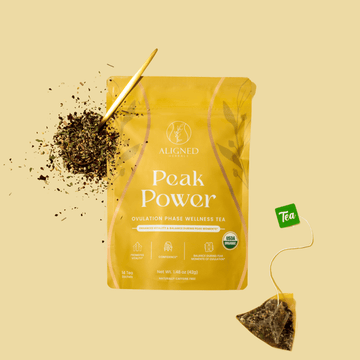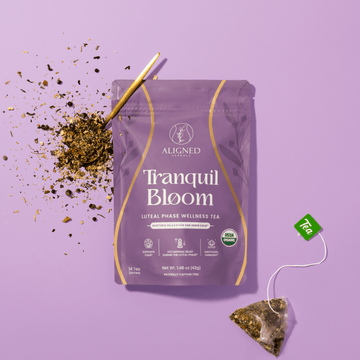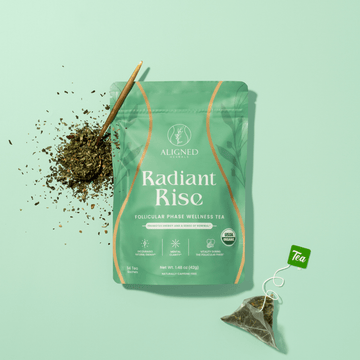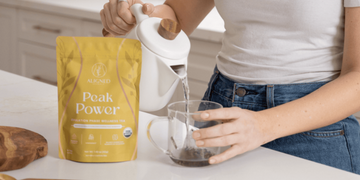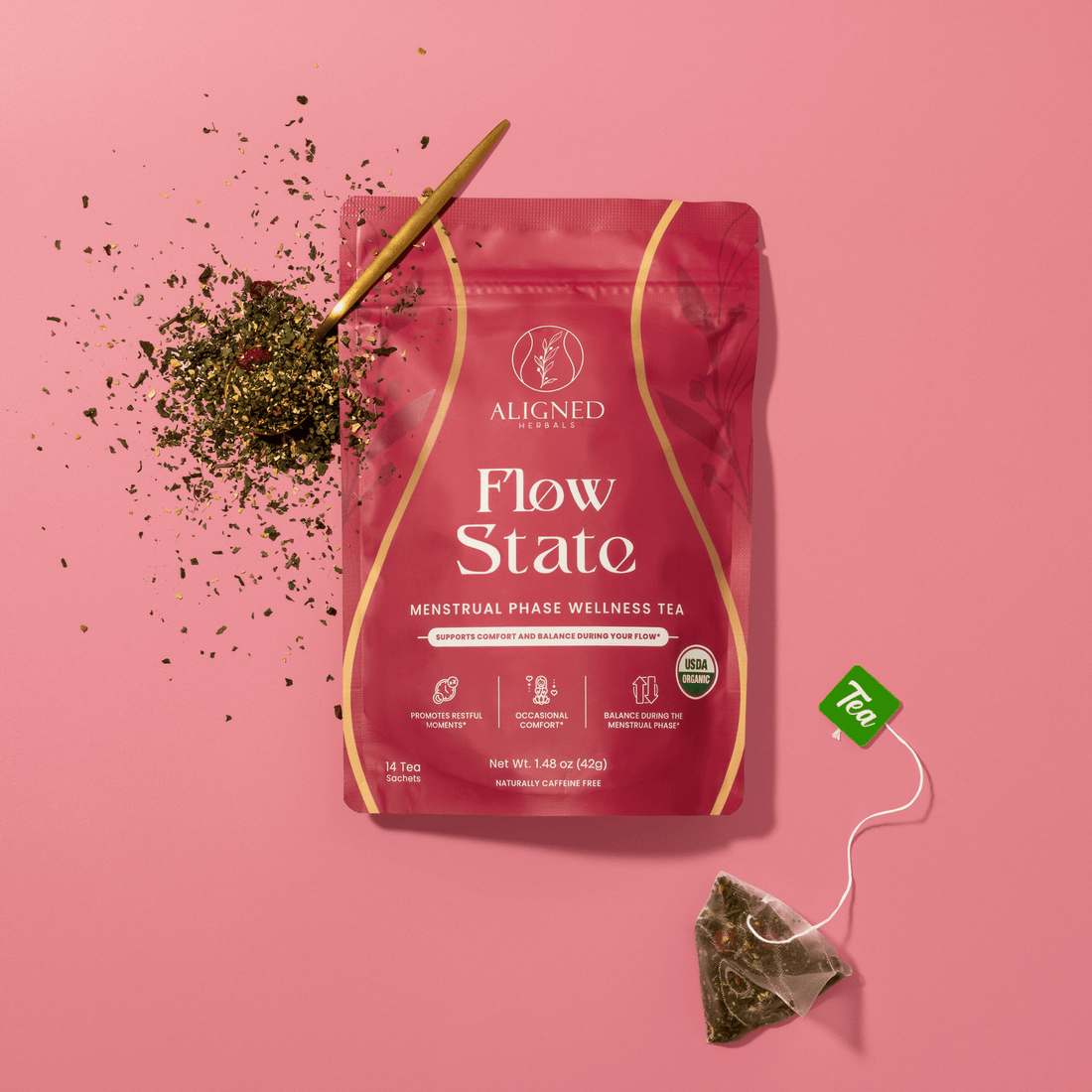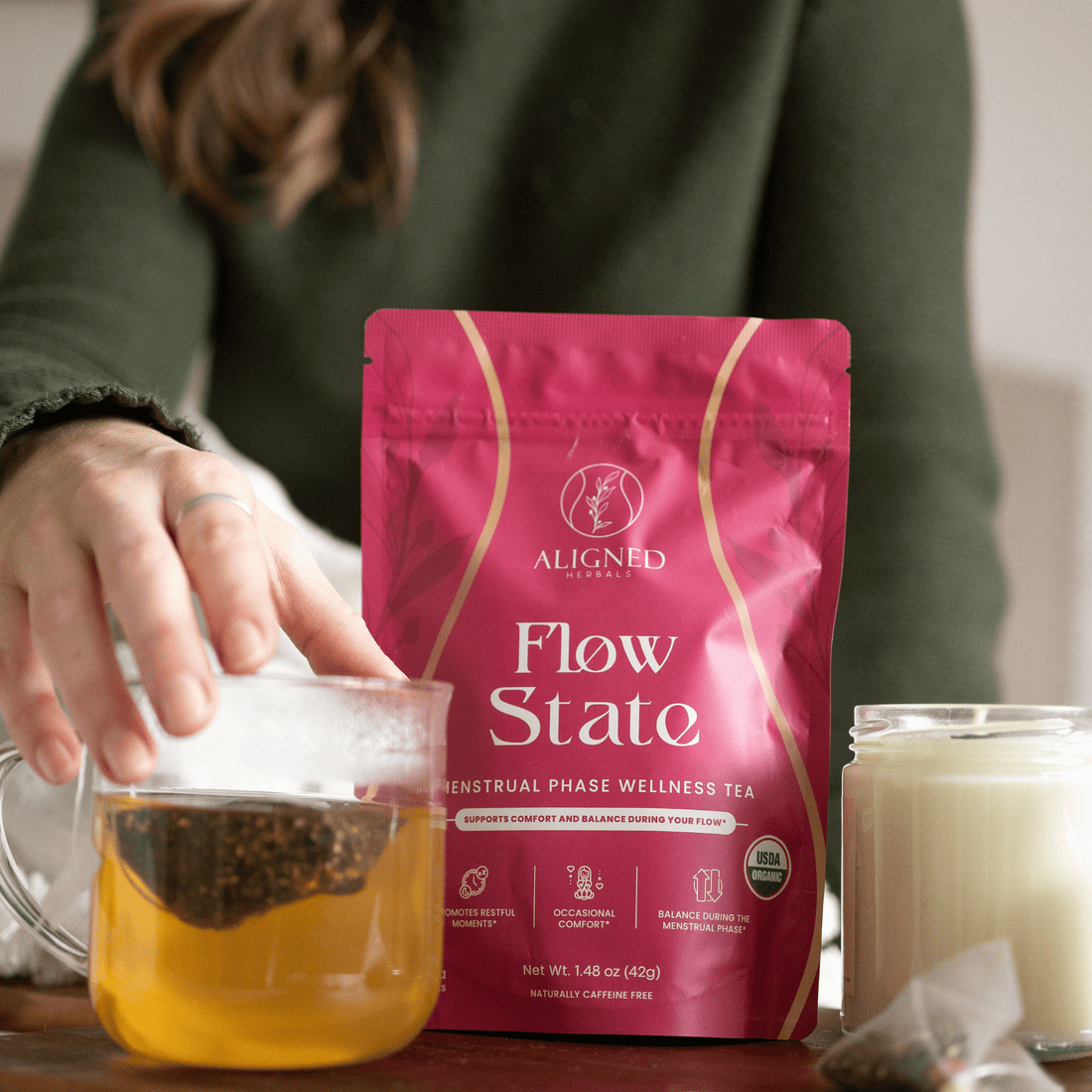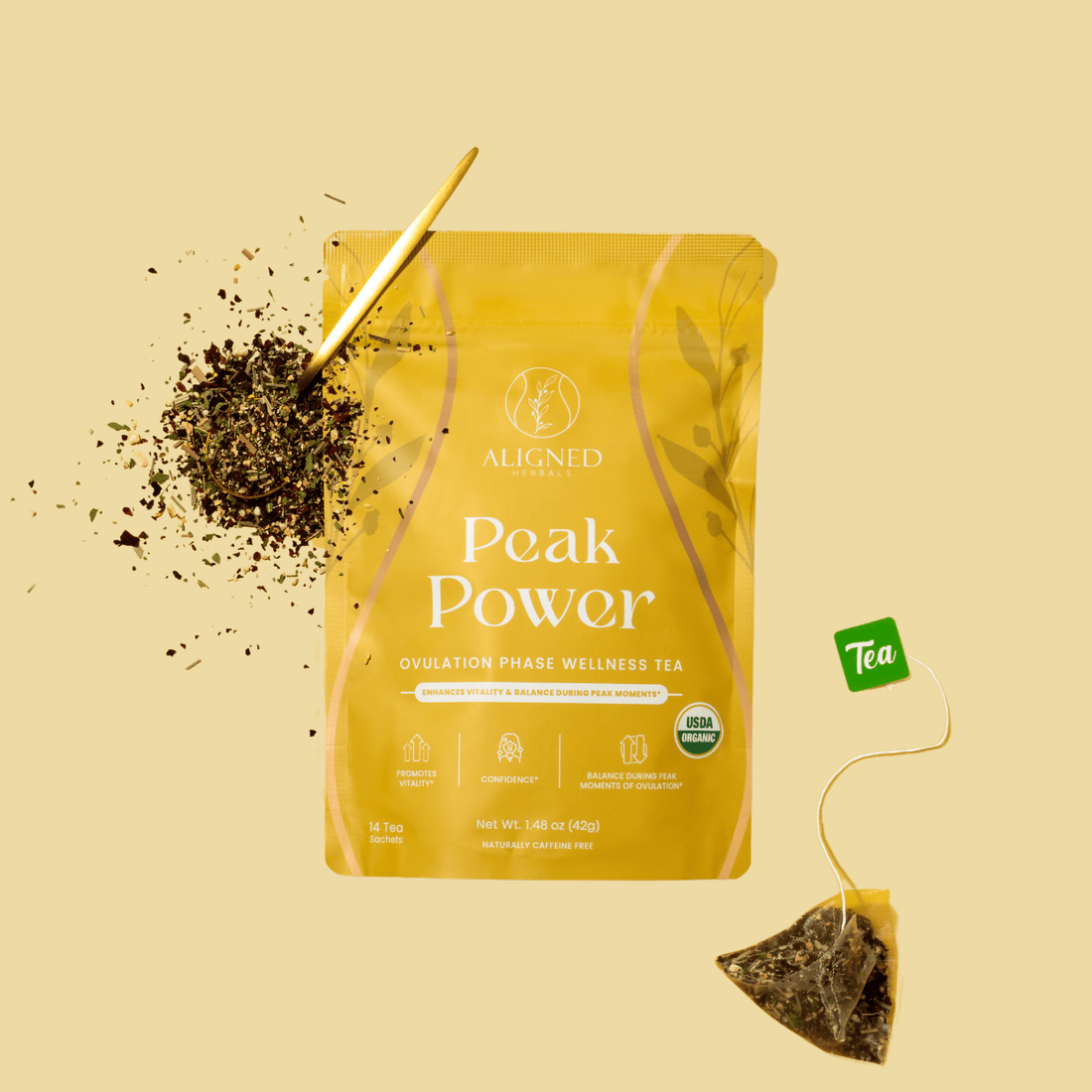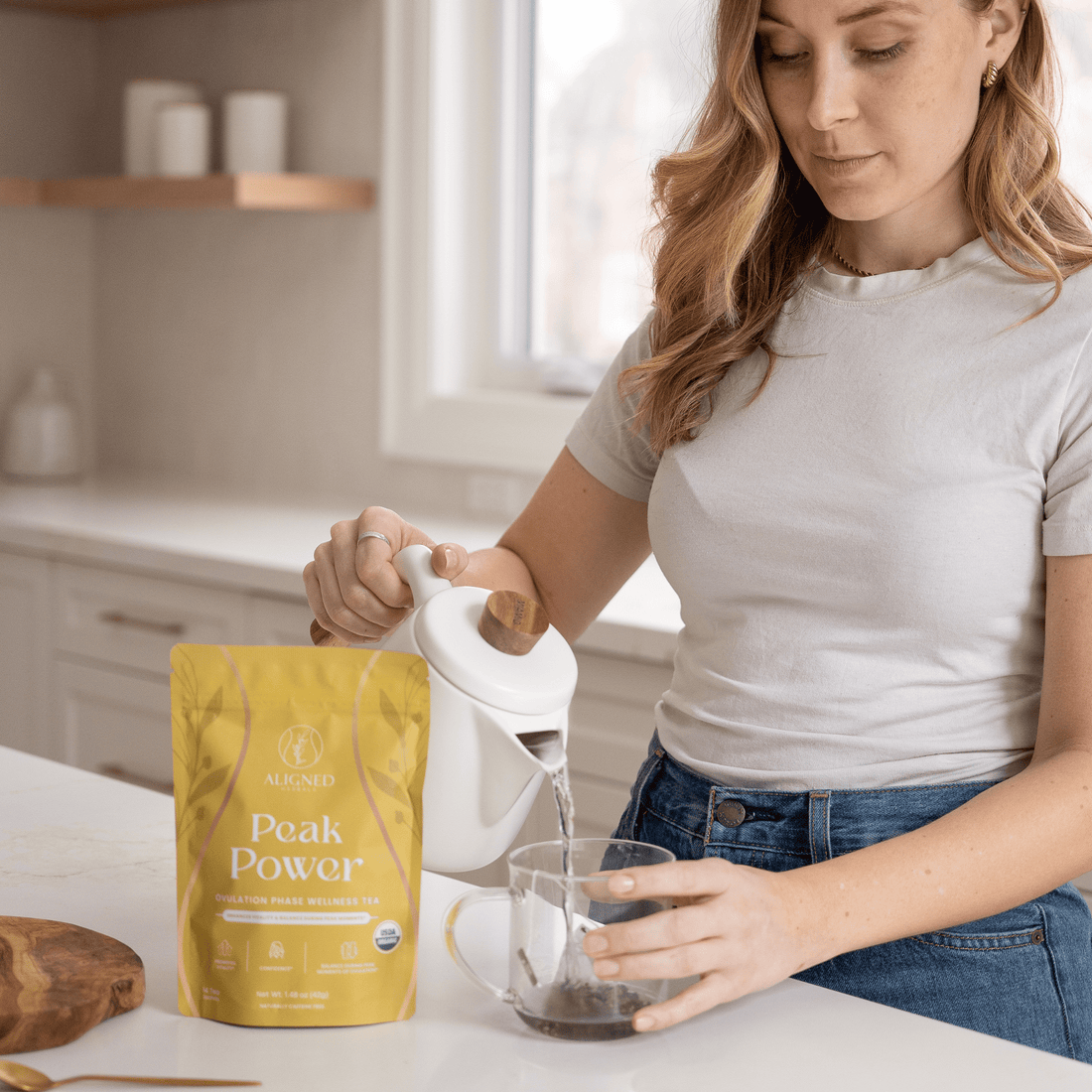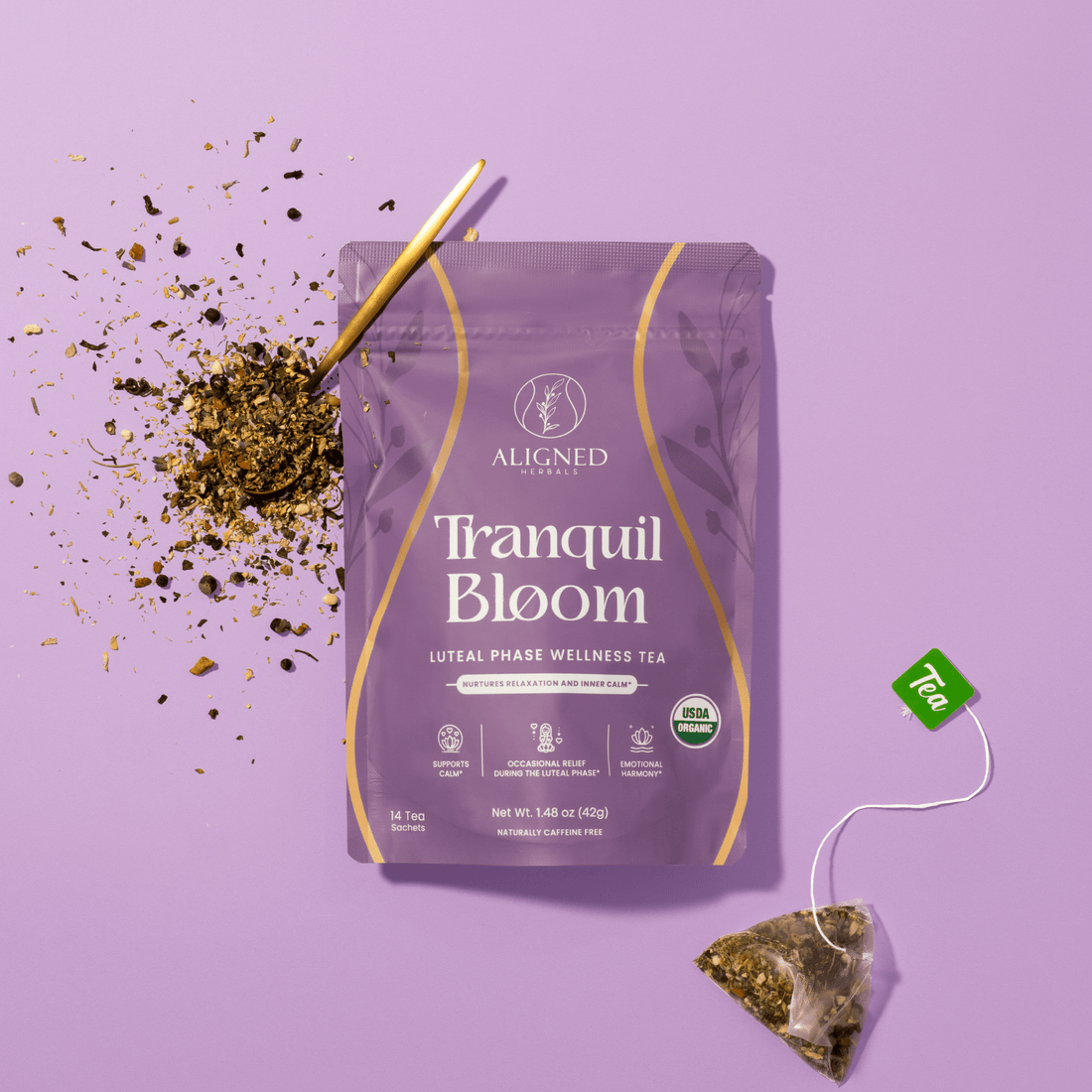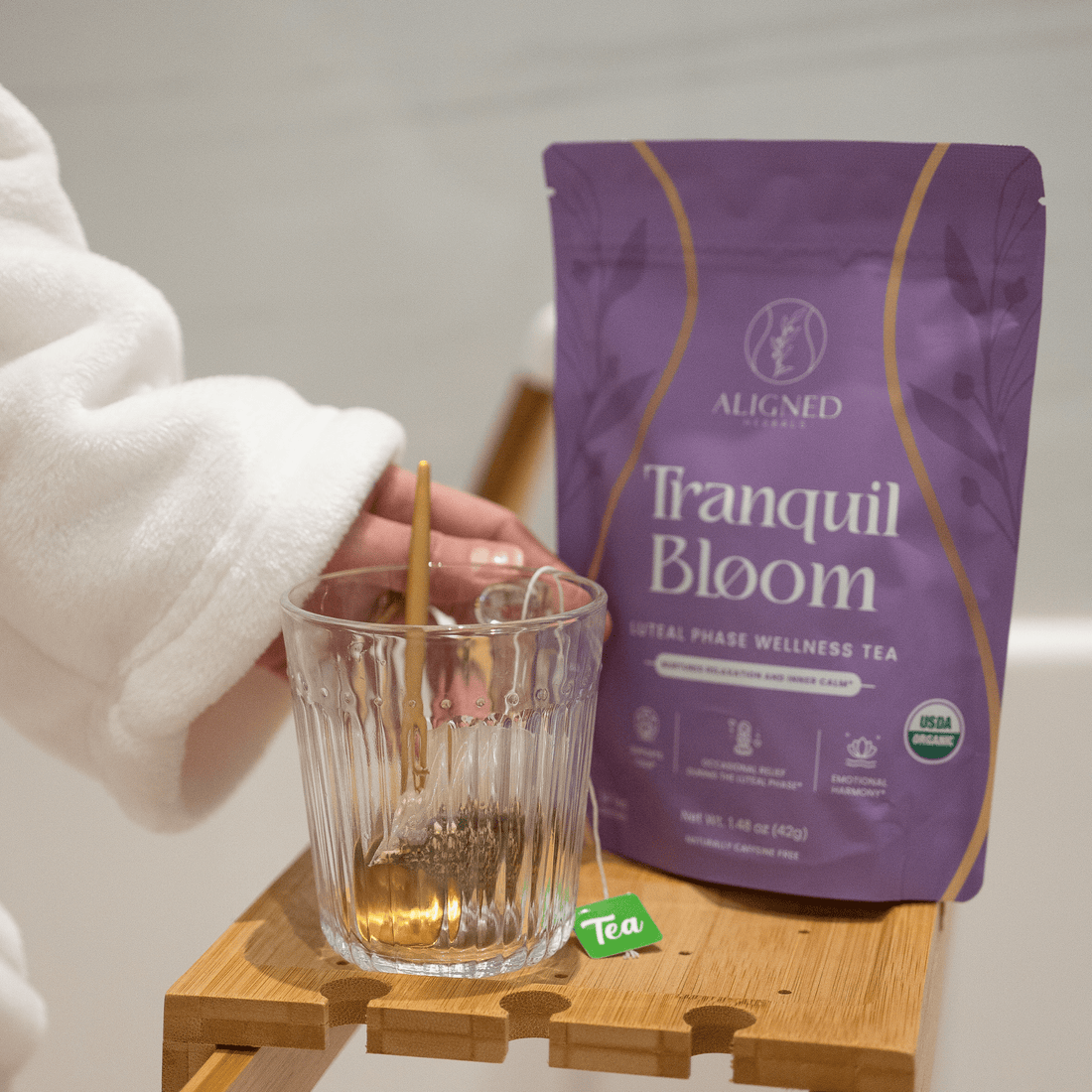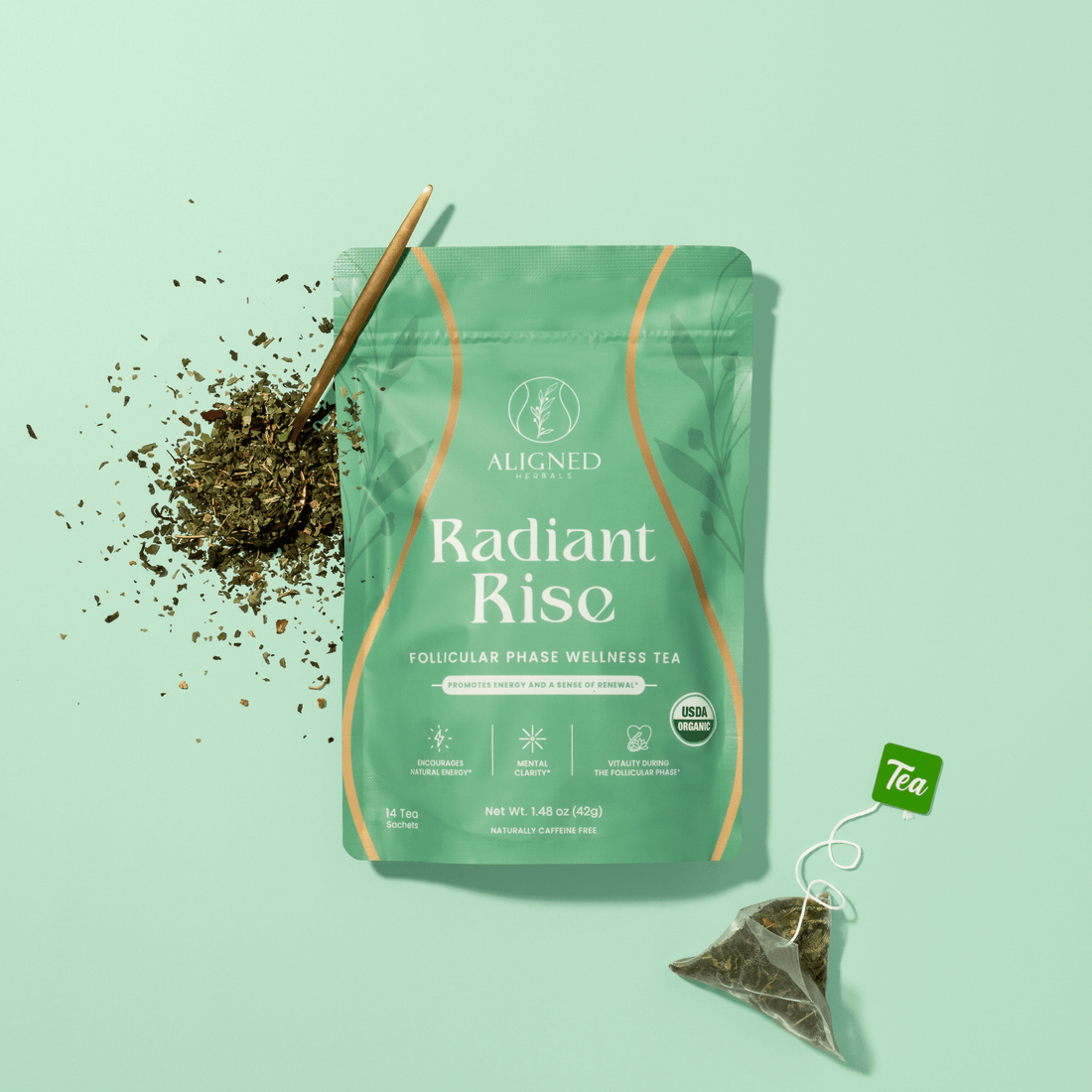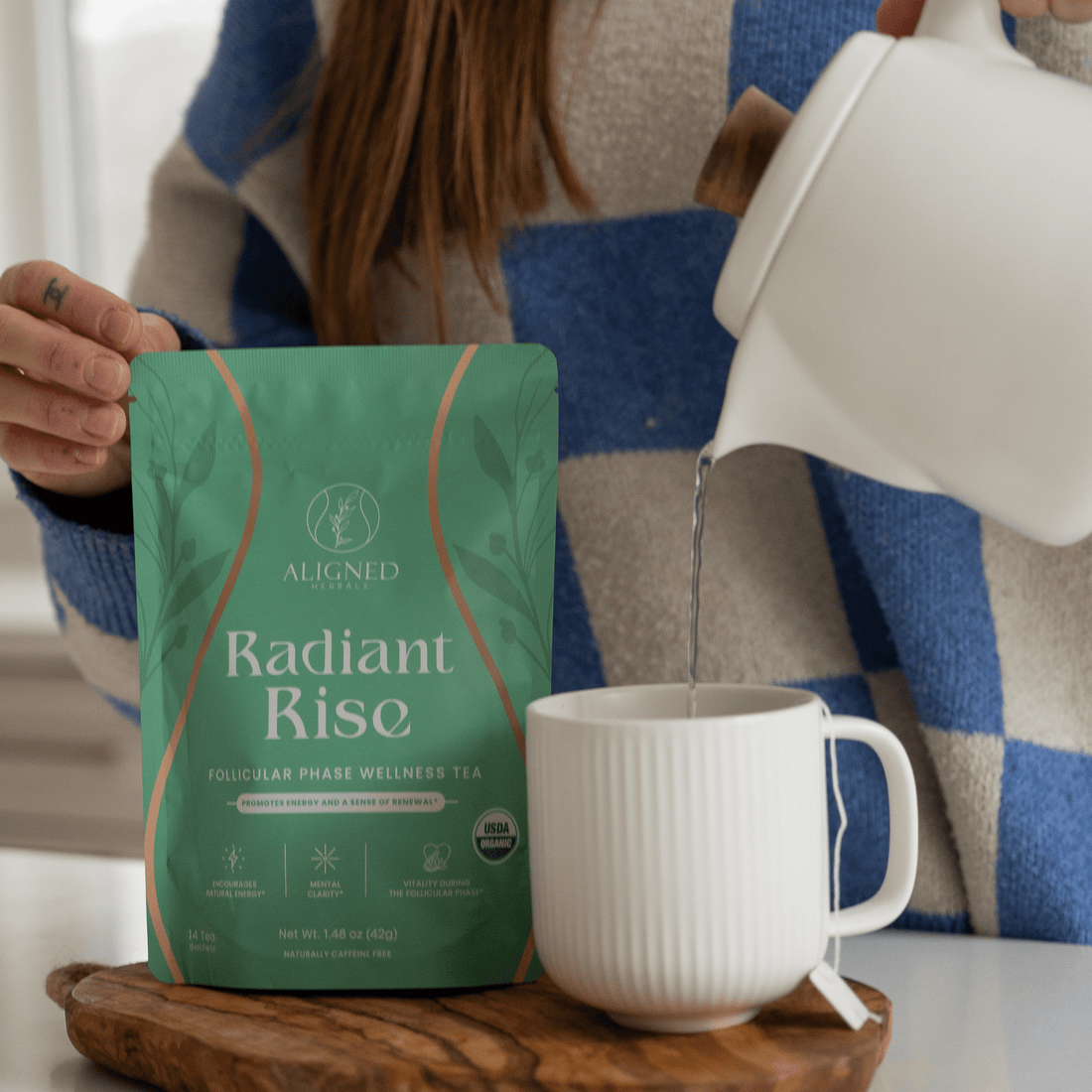Bloating During Ovulation? Causes, Symptoms & Natural Relief
If you’re preparing for a baby, this part of your cycle matters
Mid-cycle bloat is common, normal, and—good news—manageable. Many people feel a mix of “puffy” water retention and “gassy” fullness right as the egg is about to release. Ovulation pain (called mittelschmerz) can ride along, usually one-sided and brief; it’s your body’s way of announcing a key moment.
When you understand the why, you regain choices: what to sip, when to move, how to dine out, and which calm-your-nervous-system cues actually reduce visible distension. That’s our lane at Aligned Herbals— marrying evidence with everyday rituals so you can focus on what matters: feeling ready to meet your baby.
- Estrogen surge → can influence body-fluid regulation via RAAS, contributing to that “puffy” feeling.
- Progesterone rise → relaxes smooth muscle & slows gut motility for some, trapping gas more easily.
Why does ovulation bloating happen? (Science, simply explained)
The hormone wave behind the bloat
In the final days before ovulation, estrogen crests. Among its many jobs, it can tweak how your body manages water and sodium—largely through the renin-angiotensin-aldosterone system (RAAS). Translation: you may hold onto a bit more fluid, especially around the abdomen and hips. That’s the soft, generalized “puff.”
Right after the egg releases, progesterone begins its gentle climb. It’s a relax-and-receive hormone; great for conception, but it can also relax the smooth muscle of your GI tract. When motility slows, gas lingers longer, and the belly can look and feel more distended—especially after larger or higher-FODMAP meals.
Micro-timeline you can feel
| Phase | What hormones do | What you might notice |
|---|---|---|
| Late follicular (pre-ovulation) | Estrogen peaks; RAAS activity can favor holding fluid | Soft “water bloat,” rings feel snug, belly looks smooth-puffy |
| Ovulation | Follicle ruptures; local fluid/prostaglandins may irritate nearby tissue | One-sided twinge (mittelschmerz), sometimes brief spotting |
| Early luteal (days after ovulation) | Progesterone rises; gut motility often slows | “Gassy” bloat after certain meals; more burps, slower bathroom rhythm |
Ovulation pain vs. bloat (and both at once)
Pain and pressure aren’t the same—though they love to show up together. Bloat is volume (fluid or gas). Ovulation pain is usually a quick, one-sided pinch caused by the ovary doing its job. If your pain is intense, lasts beyond two days, or doesn’t match your usual pattern, loop in your clinician to rule out cysts or other concerns. :contentReference[oaicite:8]{index=8}
Where your daily choices help (and how tea fits)
Hydration with electrolytes, a short post-meal walk, breath that drops your shoulders—these are powerful levers. So is a calming tea ritual. Our mid-cycle blend was crafted to support comfort while you’re trying to conceive. If you want a ready-to-sip option, explore our herbal best-sellers bundle for a ritual that travels from office to dinner date.
Quick self-check: Is this ovulation bloat, PMS bloat, or implantation?
When you’re trying to conceive, every sensation feels amplified. That flutter. That fullness. That tiny twinge. Use this quick, zero-guilt check to name what you’re feeling—so you can respond with confidence (not Google spirals).
Pattern decoder—timeline & feel
| What you’re feeling | When it tends to show up | How it usually feels | Notes you’ll actually use |
|---|---|---|---|
| Ovulation bloat | Mid-cycle (~cycle days 12–16, but varies) | “Puffy” water retention or gassy after meals | May pair with one-sided twinge (mittelschmerz) and egg-white cervical mucus. |
| PMS bloat | Late luteal (about 3–7 days before your period) | Fluid retention Cravings & mood shifts | Often joins breast tenderness and the classic “why are my rings tight?” moment. |
| Implantation “bloat” | ~6–10 days after ovulation (if it happens at all) | Usually subtle Crampy/spotting possible | True implantation isn’t typically “balloon belly.” Many feel nothing—totally normal. |
Tap to expand—answer the 3 clarifying questions
If it’s the middle of your cycle and you’re seeing stretchy cervical mucus, ovulation bloat is most likely. Late-cycle with mood shifts and breast tenderness? That’s probably PMS bloat.
“Puffy all over” points to fluid shifts. A meal-by-meal swell that eases after passing gas points to motility and fermentation.
Brief, one-sided pelvis pain around mid-cycle supports the ovulation story. Persistent or severe pain is not typical—get care.
Soft decorative background to emphasize calm and clarity.
Want a low-lift ritual? Pack a thermos and sip through the day—try our curated herbal best-sellers bundle if you love variety but need simplicity.
Relief that actually helps (ranked by mechanism)
When you know the mechanism, you can choose the method. Below, pick your path—puffy water-retention or gassy slow-motility. Blend both if you’re getting a mixed bag (very common).
For water-retention “puffy” bloat
Hydrate like a pro (and yes, salt matters)
Think steady sips, not chugging. Add potassium-rich foods (leafy greens, potatoes, avocado) and keep sodium moderate—especially on restaurant nights.
Move fluid, gently
A brisk 15-minute walk or light cycling acts like a natural pump. Lymph loves movement; your waistband will, too.
Tea support that makes sense pre-pregnancy
Hibiscus and lemongrass are popular for hydration support and a clean, bright flavor. Enjoy them before pregnancy; if there’s a chance you’re pregnant, check with your clinician first.
Prefer a done-for-you blend? Explore our ovulation-phase wellness tea crafted for calm, clarity, and mid-cycle comfort: Peak Power ovulation tea.
For gas-trapping “gassy” bloat
Meal architecture (keep it friendly for 3–7 days)
Go easy on your biggest trigger category: onion/garlic, certain beans, ultra-rich dairy, or big portions of high-FODMAP fruit. Swap in grilled protein, rice or potatoes, cooked veggies, and olive oil.
Fiber rhythm—no whiplash
Keep soluble fiber consistent (chia, oats). Sudden “health kicks” with huge fiber jumps can backfire during ovulation week.
Breath + posture = less pressure
Two minutes of diaphragmatic breathing lowers intra-abdominal pressure and helps gas move. Shoulders soft, jaw unclenched, belly expands on inhale.
Mix-and-match plan (save this)
| Moment | Do this | Why it works |
|---|---|---|
| Morning | 12–16 oz water, light stretch, simple breakfast (eggs + potatoes + sautéed greens) | Hydrates steadily, avoids early FODMAP overload, wakes up motility. |
| Lunch | Grilled chicken or tofu bowl with rice, cooked veg; 10-minute walk after | Low-fermentation base; movement mobilizes fluid and gas. |
| Afternoon | Calming tea ritual and 2 minutes of slow breathing | Hydration + parasympathetic shift reduces visible distension. |
| Dinner out | Choose grilled mains, sauces on the side, skip sparkling drinks | Restaurant sodium + carbonation = bloat combo; this keeps it elegant and easy. |
Herbal support during ovulation (pre-pregnancy) & how Peak Power fits
You’re preparing to become a mom. You want energy for the baby-making logistics, a calmer nervous system for clear decisions, and a belly that isn’t stealing the spotlight. Smart herbal support can help you feel centered while your hormones do their incredible dance.
What matters most right now
Clarity: choose herbs that complement the mid-cycle hormone wave without promising miracles. We’re here for comfort, not cure-alls.
Simplicity: one consistent ritual beats a cabinet full of half-used jars.
Safety: enjoying botanicals before pregnancy is different from using them during pregnancy. When there’s a chance you’re pregnant, pause and talk to your clinician.
Ingredient deep-dive (pre-pregnancy lens)
| Ingredient | Why it’s here | Bloat angle | Pregnancy note |
|---|---|---|---|
| Maca root | Traditionally used for energy & mood balance | Steadier energy → fewer stress-induced gut flares | Pause when pregnant unless provider advises |
| Rose petals | Calming ritual, gentle aromatics | Relaxed nervous system may ease visible distension | Generally tea-level amounts are used with care; confirm with your provider |
| Red clover | Phytoestrogenic tradition for cycle harmony | Not a direct debloating herb | Avoid in pregnancy/lactation unless cleared clinically |
| Damiana + Vanilla | Uplift & smooth flavor | Stress → gut tension; mood support may help indirectly | Avoid in pregnancy due to limited data |
| Lemongrass | Bright, clean sip; ritual-friendly | Traditionally carminative; pleasant for “puffy” days | Pause once pregnant unless advised otherwise |
| Hibiscus | Refreshing; hydration support | Nice for water-retention vibes pre-pregnancy | Avoid in pregnancy (precaution) |
How Peak Power fits your mid-cycle
Imagine a ritual you look forward to: hot steam, floral-citrus notes, a deeper breath. That’s the intention behind our ovulation-phase blend—crafted for comfort when hormones crescendo and you still have a life to live.
Raspberry Leaf Tea before Birth: What the evidence actually says
Raspberry leaf tea has a reputation: the quiet doula in a mug. Tradition suggests it may “tone” the uterus and support smoother labor—but you deserve clear expectations. The best human studies so far are small. They often start in the late third trimester and show mixed, modest outcomes (think tiny shifts, not dramatic changes).
How it’s typically used (evidence-aligned)
Timing & dose ranges
Most protocols begin around 32–34 weeks with daily use through birth. Formats vary (tea or tablets), and doses differ by brand. Your midwife or OB should personalize this with you.
What outcomes look like
Some reports suggest slightly shorter second stage or less need for augmentation in certain groups, while others show no significant difference. Importantly, safety profiles in late pregnancy are generally favorable in studied amounts.
Who should not use it without careful supervision
If you’ve had preterm labor, specific complications, or are on medications that your provider is monitoring closely, get explicit approval first. Botanical ≠ automatically safe for everyone.
Where Flow State fits (honest, helpful, human)
During your menstrual phase (not pregnancy), many women want a warming, grounded ritual to release tension and reset. That’s where our menstrual-phase blend shines—so you enter your next cycle with resilience, not depletion.
If you’re curious about that ritual, take a look at our Flow State menstrual phase wellness tea. Different phase, different need—same commitment to quality and calm.
FAQs: Ovulation Bloating — Your Questions, Answered
Yes—very common. Around mid-cycle, estrogen peaks and progesterone soon follows; that combo can shift fluid and slow gut motility. For most, bloat lasts a day or two (sometimes up to several days depending on meals, stress, and sleep). If it’s severe or brand-new for you, check in with your clinician.
No. Bloat is a comfort issue, not a fertility limiter. Track fertile signs (cervical mucus changes, ovulation tests) and focus on consistency with intercourse or insemination timing. If pain is intense or cycles are irregular, a clinician can help you troubleshoot and optimize.
Check the calendar. Ovulation bloat pops up right around mid-cycle and may ride with a one-sided twinge (mittelschmerz). Implantation—if you feel anything at all—happens ~6–10 days after ovulation and is more “subtle cramp/spotting” than “balloon belly.” When in doubt, time-stamp your symptoms in a tracker; patterns beat guesswork.
Keep it elegant and simple: grilled proteins, cooked veggies, rice or potatoes, sauces on the side. Ask for no onion/garlic if they’re your kryptonite. Choose still water over bubbly; swap beer/seltzers for a small glass of dry wine if you’re drinking. And walk for 10–15 minutes after the meal—magic.
Love a rotating ritual you can take to dinner and beyond? Our curated herbal best-sellers bundle keeps things delicious and low-effort.
Raspberry leaf tea is traditionally discussed for late pregnancy labor support, not debloating. For mid-cycle comfort while you’re TTC, look instead to calming, hydration-forward blends and steady meal strategies. If you’re already pregnant, always get provider guidance before starting any new botanical.
If there’s a real chance you’re pregnant, press pause and talk with your clinician before continuing any herbal blend—including those with hibiscus, damiana, or red clover. If you’re in your pre-pregnancy window and want a soothing mid-cycle ritual, explore our Peak Power ovulation tea and use it consistently, not excessively.
